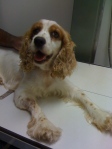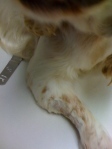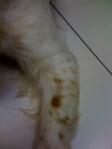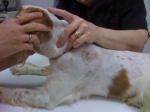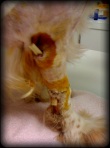4-Year-Old Cocker Spaniel Attacked by Large Dog
Cocker Spaniel Attacked by Neighboring Dog
Angel wagged her stump and looked up trustingly at Doc Truli. Her shaved, soft buff fur on her right front leg opened up in angry red bloody gashes. Her right elbow looked and felt twice as large as the normal left elbow. Angel relished the attention inspire of the obvious pain she must have felt.
“What happened?” asked Doc Truli.
Miami, FL 8:37 pm EST daylight savings
4-year-old 10kg/22lb female spayed buff cocker spaniel escapes put front door of her house, runs across street to yard belonging to 2-year-old male neutered brown and white American Bulldog. They are not friends.
American Bulldog defends his yard, rips Cocker Spaniel a few new ones.
American Bulldog parent feels horrible. Cleans wounds. Applies triple antibiotic. Applies gigantic bandage from human sports medicine section at pharmacy. No one thinks of calling or visiting an animal emergency room. Baby aspirin administered at 10 pm does not help Angel sleep. 10 am, both pet parents show up at your Truli’s hospital for help. Angel’s whole leg is swollen, pus oozes from her wounds, and she did not want to eat breakfast.
Surgery for a Dog Bite Wound
This photo shows an “after” surgery shot of the extent of the hole underneath Angel’s skin. The teeth penetrated the skin and lifted the upper layer of skin off of the muscles underneath, creating an air and bacteria filled pocket for pus to linger. The drain extends the length of the pocket and provides drainage for the bite wound for 3-5 days.
Once the draining decreases, the drain is pulled to prevent dirt and bacteria from traveling back into the wounds. The holes seal over and heal up. In 10-14 days, Angel can have her stitches removed and be good as new again!
Basic Penrose Drain Care for a Dog
- Do not let your pet eat or chew the drain. If pieces are left in the wound, the wound will fester and not heal. Most Penrose drains come embedded with a strip that will show on an X-Ray to check if a piece has been left in the wound! (An Elizabethan “cone” collar helps! Many pet stores now sell them, or you can make one with an old plastic bucket by making a hole in the bottom of the bucket, and well, bottoms up! Put the bucket on your pooch’s head!)
- Clean the openings twice daily with dilute Chlorhexidine solution (from the vet’s), or, as in Angel’s case, iodine (the brown-orange color on her fur is iodine scrub solution.) The idea is to keep the drains open so infection does not pocket under the skin and attack the body.
- Take the drain to your vet for removal when the veterinarian prescribes (usually 3-5 days), so infection does not get up into the drain.
- Ask your vet: Some veterinarians like to always leave a bandage over these drains to catch infection and protect the wound. Some like the fresh air to keep the wound open and draining. Ask your veterinarian which way they think is best.
- Also Ask your vet: Some veterinarians like the drain “flushed” daily with a sterile hospital solution they give to clean debris and infection out of the wound. Other veterinarians do not want you to inadvertently push infection deeper by inappropriate flushing. Follow your veterinarian’s advice!
What could Angel’s papa have done better?
Give your ideas, then check back for VirtuaVet’s tips for dog attack first aid, and reasons to go to the animal emergency room!

